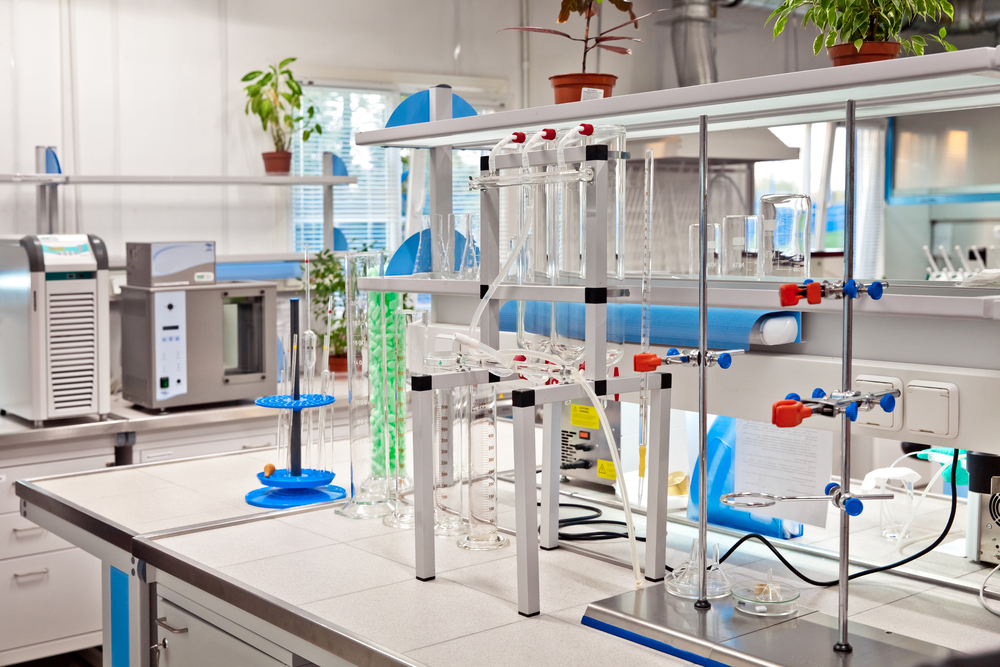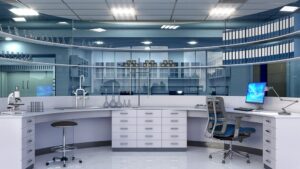
In the world of scientific research and industrial development, precision is everything. Whether you’re conducting critical measurements, analyzing microscopic structures, or working with delicate instrumentation, even the slightest disturbance can affect the accuracy and reliability of your results.
One of the most overlooked sources of such disturbances in a laboratory is vibration. Vibrations, no matter how minor, can interfere with sensitive equipment, compromise data integrity, and undermine the success of experiments.
To combat this challenge, anti-vibration tables have become a fundamental tool in precision labs across various fields. These specialized tables are designed to isolate equipment from external vibrations, ensuring that measurements remain accurate and experiments can proceed without disruption.
In this article, we’ll explore why anti-vibration tables are so crucial in modern laboratories, the science behind how they work, and how to choose the right solution for your specific lab environment.
Understanding Vibrations in Laboratory Settings
In a laboratory environment, vibrations are an often invisible yet persistent challenge. These tiny, almost imperceptible movements can arise from various sources, many of which are part of the everyday operations of a building.
Common causes of vibrations include nearby heavy machinery, HVAC systems, foot traffic, and even vibrations from neighboring rooms or floors. External factors, such as construction activity or passing vehicles, can also contribute to this issue.
While these vibrations may seem trivial, they can have a profound impact on precision work. For sensitive laboratory instruments—like microscopes, analytical balances, or laser systems—even the smallest vibrations can distort measurements or blur images, leading to compromised results.
For instance, an ultra-sensitive balance may register minute changes in mass, which can be skewed by a constant background vibration, resulting in inaccurate readings. Over time, these vibrations can affect data quality and degrade the performance of delicate equipment.
Many laboratory environments also house instruments that require extremely stable conditions to perform at their best.
Instruments like atomic force microscopes (AFMs) or interferometers demand isolation from the slightest movement, as their level of precision operates on the microscopic or even nanoscopic scale. In such cases, environmental control, including vibration isolation, becomes critical to ensure the success and repeatability of experiments.
The significance of controlling vibrations becomes even more apparent when considering the need for high reproducibility in scientific research. With normal lab tables and workstations without proper vibration management, experimental results can vary widely, leading to inconsistent data and flawed conclusions.
This is where anti-vibration tables play a pivotal role—by neutralizing the effects of external vibrations, they create a stable and controlled environment where precise work can thrive.
Types of Precision Instruments Affected by Vibrations

Precision instruments are the backbone of scientific discovery and industrial research, often working at micro- or nano-levels, where even the slightest interference can distort results. In many laboratories, controlling vibrations is essential to ensure the accuracy and reliability of the instruments being used.
Let’s explore some of the most commonly affected precision instruments and how vibrations can compromise their performance.
1. Analytical Balances
Analytical balances are among the most sensitive instruments in a laboratory, capable of measuring down to micrograms or even nanograms. However, their accuracy can be easily disrupted by external vibrations.
Any minor tremor, such as foot traffic or building vibrations, can cause fluctuations in measurements, making it difficult to obtain precise readings. This is particularly critical in laboratories dealing with chemical formulations, pharmaceuticals, or research where exact quantities are vital.
2. Microscopes (Optical and Electron)
Microscopes, especially electron and high-powered optical microscopes, require a vibration-free environment to produce clear, detailed images. Vibrations can blur images, making it nearly impossible to focus on fine details at high magnifications.
For example, in biological research, where scientists observe cell structures or tissues, or in materials science, where researchers investigate surface properties, maintaining clarity and stability is essential to achieve accurate observations.
3. Atomic Force Microscopes (AFMs)

Atomic Force Microscopes (AFMs) operate at the nanoscale, scanning surfaces with incredible precision to measure forces and generate detailed surface maps. At this level of sensitivity, vibrations can significantly distort the data collected, resulting in inaccurate surface representations or compromised force measurements. AFMs are used in fields like nanotechnology, materials science, and molecular biology, where precision is non-negotiable, making vibration isolation critical for reliable results.
4. Laser Interferometers
Laser interferometers are used to measure incredibly small displacements, changes in refractive index, or surface irregularities. They operate by splitting a laser beam and using the interference patterns between the beams to measure distances with extreme accuracy.
However, vibrations can skew the interference patterns, leading to incorrect measurements. This can pose significant issues in industries such as semiconductor manufacturing or advanced optics, where precision must be maintained at all times.
5. High-Performance Liquid Chromatography (HPLC) Systems

HPLC systems are commonly used in chemical analysis to separate, identify, and quantify components in a mixture. These systems rely on precise flow rates and stable conditions for accurate results. Vibrations can cause pressure fluctuations in the system, leading to variations in flow rates and, consequently, unreliable chromatographic results.
This is particularly problematic in pharmaceutical or food and beverage industries, where the integrity of results is crucial for quality control.
Each of these instruments plays a vital role in precision laboratory work, and their vulnerability to vibrations underscores the need for robust vibration control. Anti-vibration tables serve as a key solution, providing the stability necessary for these instruments to function optimally, ensuring that the quality and accuracy of data are maintained.
What is an Anti-Vibration Table?
An anti-vibration table is a specialized piece of laboratory furniture designed to isolate sensitive equipment from vibrations that can disrupt precision measurements and experiments. These tables are engineered to absorb, dampen, and neutralize external vibrations, creating a stable working surface essential for high-precision instruments.
At the heart of an anti-vibration table is its vibration isolation platform, which sits atop a frame equipped with dampening mechanisms. These mechanisms can vary, but typically involve the use of pneumatic supports or elastic dampers that absorb energy from vibrations, preventing them from reaching the tabletop where sensitive instruments are positioned.
This isolation is crucial because even subtle vibrations, such as those caused by nearby foot traffic, building vibrations, or the operation of adjacent machinery, can interfere with the accuracy of delicate measurements.
Anti-vibration tables come in two primary forms: passive and active systems.
1. Passive Anti-Vibration Tables

Passive anti-vibration tables are the most common type and operate without external power. These tables use elastic materials such as rubber mounts, air springs, or heavy masses to dampen and reduce vibrations naturally.
By relying on their weight and isolating materials, they can block most low-frequency vibrations that arise in everyday laboratory environments. Passive tables are ideal for instruments like microscopes, balances, and other standard lab equipment, offering a cost-effective solution for vibration control.
2. Active Anti-Vibration Tables

Active anti-vibration tables, on the other hand, are more sophisticated and involve real-time adjustment mechanisms. These tables use sensors to detect incoming vibrations and electronically controlled actuators to counteract the vibrations by applying forces in the opposite direction.
Active systems are typically used in environments where ultra-precise instruments like atomic force microscopes (AFMs) or interferometers require protection from even the slightest disturbances. While more expensive than passive systems, active anti-vibration tables offer superior vibration control, particularly for high-frequency and low-amplitude vibrations.
Beyond these essential components, many anti-vibration tables are customizable to fit specific laboratory needs. Some models are designed with adjustable leveling feet to ensure perfect balance, while others include built-in shock absorbers to further reduce environmental noise. They can also vary in size and load capacity, depending on the equipment they need to support.
Anti-vibration tables ensure the stability of delicate instruments and extend their lifespan by reducing the mechanical stress that vibrations can cause over time. In labs where precision is critical, these tables provide the reliability needed to maintain consistent, accurate results, safeguarding the integrity of scientific research and industrial processes.
Benefits of Using Anti-Vibration Tables in Labs

In precision laboratory work, where accuracy and consistency are paramount, the introduction of anti-vibration tables can bring significant advantages. These specialized tables offer multiple benefits that not only improve the quality of research but also protect valuable equipment and create safer working conditions. Here are the key benefits of using anti-vibration tables in laboratory environments:
1. Enhanced Accuracy and Precision
The most obvious and immediate benefit of anti-vibration tables is the substantial improvement in the accuracy of measurements.
By isolating sensitive instruments from external vibrations, these tables allow equipment such as analytical balances, microscopes, and laser interferometers to perform optimally without interference. This ensures that even the smallest fluctuations, which can skew results, are minimized or eliminated entirely. For labs where precision is non-negotiable, anti-vibration tables are essential for producing reliable and reproducible data.
2. Reduction of Measurement Errors
Instruments affected by vibrations are prone to generating inaccurate readings, especially over long periods of use. An anti-vibration table serves as a protective barrier, significantly reducing these errors by stabilizing the environment.
For laboratories in fields like pharmaceuticals, materials science, and electronics, where precise measurements are required for quality control, the reduction of measurement errors can lead to higher confidence in experimental results and more consistent product development processes.
3. Improved Data Quality and Integrity
In many scientific experiments, the quality of data is the foundation of meaningful conclusions. Uncontrolled vibrations can distort measurements, corrupt experimental outcomes, and potentially lead to flawed research.
Anti-vibration tables create a stable environment, ensuring that data is gathered in ideal conditions, thereby enhancing the integrity of the results. This leads to more accurate scientific insights, stronger experimental reproducibility, and ultimately, more credible research findings.
4. Protection of Sensitive and Expensive Equipment

Precision instruments used in laboratories are often delicate and highly sensitive to environmental factors. Over time, continuous exposure to vibrations can cause gradual damage or misalignment in these instruments, reducing their performance and shortening their lifespan.
Anti-vibration tables act as a protective measure, reducing wear and tear on the equipment. By mitigating mechanical stress, these tables help safeguard significant investments, ensuring that expensive instruments remain in peak condition and perform consistently over time.
5. Increased Safety for Laboratory Personnel
In some lab environments, vibrations can cause instability in equipment setups, increasing the risk of accidents. Instruments that are prone to displacement or misalignment due to vibrations can become hazardous to operate.
Anti-vibration tables help maintain the stability of the workspace, reducing the chance of accidents related to shaky or unstable equipment. Safety standards are high, and this protects the instruments and ensures a safer environment for lab technicians and researchers.
6. Versatility Across Various Applications
Anti-vibration tables are used in a wide range of laboratories, from academic research facilities to industrial labs. Their versatility allows them to support different types of precision work, from pharmaceutical analysis to semiconductor testing. Regardless of the specific application, the benefits of vibration isolation remain the same—enhanced precision, improved data quality, and better equipment longevity.
By incorporating anti-vibration tables into the laboratory environment, researchers and technicians can work with greater confidence, knowing that their instruments are protected from external disturbances and their results are as accurate as possible. In the competitive landscape of scientific research and industrial innovation, this level of control is indispensable.
Additional Reading: Stainless Steel Lab Equipment: Combining Hygiene with Precision
Applications of Anti-Vibration Tables in Different Laboratory Types
Anti-vibration tables are indispensable across a wide variety of laboratory settings, where precision and stability are critical to successful outcomes. The specific requirements for vibration control may vary from one lab type to another, but the underlying need for precision remains constant. Here are some key applications of anti-vibration tables in different laboratory environments:
1. Research and Development (R&D) Laboratories

In R&D labs, where groundbreaking discoveries are made, and new technologies are developed, the precision of instruments is paramount. Whether in physics, chemistry, or biology, researchers rely on sensitive equipment to conduct complex experiments.
For example, high-resolution microscopes and spectroscopy equipment require stable conditions for accurate imaging and analysis. Anti-vibration tables ensure that these instruments perform optimally, allowing researchers to gather reliable data without the risk of external disturbances compromising their findings.
2. Medical and Clinical Laboratories

In medical and clinical labs, precision plays a direct role in patient diagnostics, treatment planning, and medical research. Instruments such as centrifuges, diagnostic balances, and microscopy equipment need to operate free of vibration interference to provide accurate results.
Anti-vibration tables help maintain the consistency of measurements, improving the reliability of diagnostics. For example, histopathology labs analyzing tissue samples or blood tests conducted on highly sensitive equipment depend on stable work surfaces to ensure proper evaluation and patient care.
3. Industrial and Quality Control Laboratories

In industrial settings, anti-vibration tables are essential for maintaining product integrity during testing and quality control. Many industries, including aerospace, automotive, electronics, and pharmaceuticals, use precision instruments such as laser interferometers, high-performance liquid chromatography (HPLC) systems, and atomic force microscopes (AFMs) to verify product specifications.
Even the slightest vibration can skew test results, leading to potential product defects or inconsistencies. Anti-vibration tables ensure that products meet stringent quality standards, helping manufacturers avoid costly errors and maintain compliance with industry regulations.
4. Pharmaceutical and Biotechnology Laboratories

Pharmaceutical and biotechnology labs rely heavily on precision instruments to develop and test new drugs and therapies. Equipment such as balances, spectrometers, and high-resolution microscopes is used to analyze chemical compounds and biological samples at the molecular level.
Anti-vibration tables play a crucial role in ensuring that the data collected during drug development is accurate, which is essential for regulatory approvals and successful product launches. By providing a stable platform for sensitive equipment, these tables enable researchers to maintain consistency and accuracy throughout the drug development process.
5. Forensics Laboratories

Forensic laboratories require the highest level of precision in their analyses, as they work to provide evidence for legal proceedings. Equipment like microscopes, DNA sequencers, and spectrometers must be free of interference to ensure that the evidence is handled and analyzed correctly.
Whether analyzing trace evidence like fibers, fingerprints, or biological samples, anti-vibration tables offer the stability needed to avoid cross-contamination or data errors. This ensures that forensic experts can provide courts with reliable, unassailable results.
6. Semiconductor and Electronics Laboratories

In the electronics and semiconductor industries, the production of microchips and other electronic components requires extreme precision. Any disruption in the production process, even at the nanometer level, can lead to faulty components.
Anti-vibration tables are critical in labs that work with laser interferometry, electron microscopy, and other equipment used in semiconductor manufacturing. By isolating sensitive processes from external vibrations, these tables help maintain the integrity of high-tech products, reducing the risk of defects and increasing production yields.
From research and medical labs to industrial and forensic environments, anti-vibration tables provide the stability needed to ensure the accuracy of high-precision work. Their ability to minimize the impact of external disturbances makes them essential across many industries, enabling scientists and technicians to achieve consistent, reliable results in every field of application.
Choosing the Right Anti-Vibration Tables

Selecting the right anti-vibration table for your laboratory can make a significant difference in the performance and longevity of your sensitive instruments. Since the requirements of each lab can vary based on the nature of the work being performed, it’s important to consider several key factors before deciding.
Below are some crucial aspects to keep in mind when choosing an anti-vibration table:
1. Type of Instruments
The first step in selecting the right anti-vibration table is to evaluate the specific instruments that will be used on it. For example, extremely sensitive instruments like atomic force microscopes (AFMs) or laser interferometers may require an active anti-vibration table to neutralize even the most minute disturbances. On the other hand, more standard equipment like analytical balances or optical microscopes may only need a passive anti-vibration table, which provides sufficient isolation for moderate levels of vibration.
Understanding the vibration sensitivity of your instruments will help you determine the level of isolation required. Highly precise equipment often benefits from tables with advanced damping mechanisms, while less sensitive instruments may function well on simpler, cost-effective solutions.
2. Vibration Sources
Identifying the sources of vibration in your laboratory is another critical factor in choosing the appropriate anti-vibration table. Vibrations can originate from both internal and external sources. Internally, HVAC systems, nearby machinery, or even foot traffic can generate vibrations. Externally, construction activity, nearby road traffic, or neighboring laboratories can contribute as well.
If your lab is located near heavy external sources of vibration, you may need a table with higher isolation capabilities or one equipped with air suspension to better dampen low-frequency vibrations.
3. Load Capacity
Anti-vibration tables are designed to support specific weight ranges, so it’s essential to match the table’s load capacity with the weight of your equipment. Overloading a table can reduce its effectiveness and may even cause mechanical failure.
It’s important to ensure that the table you select can comfortably support not only the instrument’s weight, but also any additional accessories or fixtures that might be added over time. Tables with adjustable load capacities are particularly useful for labs that house multiple instruments or frequently change setups.
4. Table Size and Workspace Requirements
The size of the anti-vibration table should correspond to the footprint of your instruments and the available space in your lab. Some instruments may only require a compact tabletop solution, while others might need a larger platform to accommodate multiple devices. It’s also critical to ensure that there is enough space around the table for operators to work comfortably without generating vibrations through direct contact.
Additionally, consider whether the table’s height and design match your workspace ergonomics. Adjustable-height models can be particularly beneficial, allowing technicians to work at comfortable levels while minimizing unnecessary vibration from frequent adjustments or repositioning.

5. Environmental Conditions
Your lab’s environmental conditions, such as temperature, humidity, and airflow, can impact the performance of anti-vibration tables. Certain materials used in the construction of these tables may be sensitive to temperature fluctuations or moisture, potentially affecting their vibration-dampening properties.
For labs with stringent environmental controls, it’s important to select a table that is compatible with these conditions. Some tables are designed with temperature-resistant coatings or moisture-resistant materials to ensure longevity and performance stability in various environments.
6. Budget Considerations
While anti-vibration tables are a critical investment for laboratories, it’s essential to balance the need for vibration isolation with your budget constraints. Passive anti-vibration tables are typically more affordable and can be sufficient for many labs, particularly those with moderate vibration control needs. Active anti-vibration tables, though more expensive, offer superior performance for high-precision applications and may be a necessary investment for labs dealing with cutting-edge research or ultra-sensitive equipment.
It’s also worth considering the long-term benefits of protecting your equipment. Investing in a higher-quality anti-vibration table may prevent costly repairs or replacements down the line, making it a cost-effective choice in the long run.
By carefully assessing the needs of your laboratory, the characteristics of your equipment, and your workspace conditions, you can select the anti-vibration table that will provide the best stability and precision. A well-chosen table will enhance your lab’s performance, reduce measurement errors, and protect your sensitive instruments, making it an essential component for any precision lab environment.
Conclusion
In today’s advanced laboratory environments, where precision is the cornerstone of success, even the smallest vibrations can have significant consequences. Anti-vibration tables provide an essential solution to this challenge, offering stability, protecting sensitive instruments, and ensuring that high-quality data can be gathered without interference.
Whether in research, industrial, or clinical settings, these tables have become a vital tool in maintaining accuracy, improving results, and safeguarding equipment. Investing in the right anti-vibration table tailored to your laboratory’s needs can make all the difference in achieving consistent and reliable outcomes.
From enhancing precision to extending the lifespan of critical instruments, the benefits are clear. As laboratories continue to push the boundaries of science and technology, the role of anti-vibration tables will only grow in importance.
Are you looking to enhance the precision and reliability of your lab’s operations? Consult our experts and discover the best anti-vibration solutions for your lab. Whether you’re working with ultra-sensitive equipment or conducting high-precision experiments, we offer solutions tailored to your specific needs, all in compliance with SEFA standards. Learn more about the services offered by Genie Scientific here.




